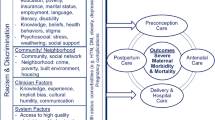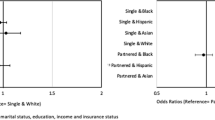Abstract
Objective
To assess the impact of the HealthChoice program in Maryland on cesarean section and vaginal birth after C-section deliveries.
Study Design
Pre-post design using a comparison group with Maryland State Inpatient Databases, part of the Healthcare Cost and Utilization Project, developed by the Agency for Healthcare Research and Quality. Although the combined 1995 and 2000 database contained over 1.2 million inpatient discharge records, the analysis included all hospital discharge abstracts for women in labor. To identify the delivery, Diagnoses-Related Groups (DRGs) 370–375 were used from the discharge data. Together, there were 128,743 births identified in both years.
Methods
Pregnant women enrolled in Medicaid managed care were compared pre-implementation and post implementation with pregnant women delivering babies under private insurance. The analysis computed difference-in-differences estimates using a logistic regression model that controlled for maternal characteristics, payment source, labor and delivery complications, and hospital characteristics. The outcome variables included Primary Cesarean, Repeat Cesarean, and Vaginal Birth after C-section.
Results
These results suggest that Medicaid managed care enrollees were less likely to undergo cesarean section deliveries relative to privately insured beneficiaries. Medicaid MCOs may have done a better job of limiting the growth in overused procedures than did MCOs and providers for privately insured women.
Conclusion
This study has shown that there has been an overall increase in the use of primary and repeat cesarean sections in Maryland hospitals. However, HealthChoice limited this increase for Medicaid enrollees relative to privately insured women. On the other hand, vaginal births after C-section have declined in Maryland.
Similar content being viewed by others
References
Centers for Medicare and Medicaid Services. (2003). Medicaid managed care overview. Baltimore, MD. Available at: http://www.cms.hhs.gov/medicaid.
Schwalberg, R., Mathis, S. A., Giffen, M., Mohamadi, L., & Zimmerman, B., Sines, E. (2001). Medicaid coverage of perinatal services: Results of a National Survey. Menlo Park, California: Henry J. Keiser Family Foundation.
Sharkey, P. D., Derrick, F. W., Freeze, J., & Bush, R. et al. (2000). Opportunities and challenges in Medicaid managed care: The experience in Maryland. The American Journal of Managed Care, 6(3), 341–350.
Figura, S. Z. (1997). Maryland Medicaid marries choice and managed care. AHA News. 33(24), 6.
Ware, J. E., Bayliss, M. S., Rogers, W. H., Kosinski, M., & Tarlov, A. R. (1996). Differences in 4-year health outcomes for elderly and poor, chronically ill patients treated in HMO and fee-for-service systems. Journal of American Medical Association, 276(13), 1039–1047.
Shaugnessy, P. W., Schlenker, R. E., & Hittle, D. F. (1994). Home health care outcomes under capitated and fee-for-service payments. Health Care Financing Review, 16(1), 187–222.
Haile, P. A., & Stein, R. M. (2002). Managed care incentives and inpatient complications. Journal of Economics and Management Strategy, 11(1), 37–79.
Hellinger, F. J. (1998). The effect of managed care on quality: A review of recent evidence. Archives of Internal Medicine, 158(8), 833–841.
Yelin, E. H., Criswell, L. A., & Feingenbaum, P. G. (1996). Health care utilization and outcomes among persons with rheumatoid arthritis in fee-for-service and prepaid. Group practice settings. Journal of American Medical Association, 276(13), 1048–1053.
Greenfield, S., Rogers, W., Mangotich, M., Carney, M. F., & Tarlov, A. R. (1995). Outcomes of patients with hypertension and non-insulin dependent diabetes Mellitus treated by different Systems and Specialties. Journal of American Medical Association, 274(18), 1436–1444.
Quick, J. D., Greenlick, M. R., & Roghmann, K. J. (1981). Prenatal care and pregnancy outcome in an HMO and general population: A multivariate cohort analysis. American Journal of Public Health, 71(4), 381–389.
Carey, T. S, Weis, K., & Homer, C. (1991). Prepaid versus traditional Medicaid plans: Lack of effect on pregnancy outcomes and prenatal care. Health Services Research, 26(2), 165–181.
Goldfarb, N. I., Hillman, A. L., Eisenberg, J. M., Kelley, M. A., Cohen, A. V., & Dellheim, M. (1991). Impact of mandatory Medicaid case management program on prenatal care and birth outcomes: A retrospective analysis. Medical Care, 29(1), 64–71.
Krieger, J. W., Connell, F. A., & LoGerfo, P. (1992). Medicaid prenatal care: A comparison of use and outcome in fee-for-service and managed care. American Journal of Public Health, 82(2), 185–190.
Blendon, R. J., Mollyann, B., & Benson, J. M. et al. (1998). Understanding the managed care backlash. Health Affairs, 17(4), 80–94.
Miller, R. H., & Luft, H. S. (1997). Does managed care lead to better or worse quality of care? Health Affairs, 16(5), 7–25.
Oleske, D. M., Branca, M. L., Schmidt, J. B., Ferguson, R., & Linn, E. S. (1998). A comparison of capitated and fee-for-service Medicaid reimbursement methods on pregnancy outcomes. Health Services Research, 33(1), 55–73.
Levinson, A., & Ullman, F. (1998). Medicaid managed care and infant health. Journal of Health Economics, 17(3), 251–268.
Riley, G. F., Potosky, A. L., Lubitz, J. D., & Brown, M. L. (1994). Stage of cancer at diagnosis for medicare HMO and fee-for-service enrollees. American Journal of Public Health, 84(10), 1598–1604.
Roohan, P. J., Anarella, J. P., & Gesten, F. C. (2004). Quality oversight and improvement in Medicaid managed care. Journal of Public Health Management Practice, 10(4), 321–329.
Womeodu, R. J., Graney, M. J., Gibson, D. V., & Bailey, J. E. (2003). Diabetic patient experiences in a Medicaid managed care system. Tennessee Medicine, 96(10), 465–469.
Howell, E. M., Dubay, L., Kenney, G., & Sommers, A. S. (2004). The impact of Medicaid managed care on pregnant women in Ohio: A cohort analysis. Health Services Research, 39(4), 825–846.
Menacker, F., & Curtin, F. C. (2001). Trends in cesarean birth and vaginal birth after previous cesarean, 1991–1999 (DHHS Publication No. PHS 2002–1120). Hyattsville, MD: Department of Health and Human Services. National Center for Health Statistics.
Agency for Health Care Research and Quality. (2002). Care of women in U.S. hospitals, 2000 (HCUP Fact Book No. 3, AHRQ Publication No. 02-0044). Rockville, MD: Agency for Health Care Research and Quality.
Cesarean Fact Sheet. ICEA Cesarean Options. Childbirth.Org. Available at: http://www.childbirth.org/section/CSFact.html .
University of Michigan Health System. (2004). Women’s Health Advisor 2004: Vaginal birth after a previous cesarean delivery. University of Michigan. Available at: http://www.med.umich.edu/1libr/wha/wha_vbac_crs.htm .
Introduction to The HCUP State Inpatient Databases. (2006). Healthcare Cost and Utilization Project. Agency for Healthcare Research and Quality, Rockville, MD. Available at: http://www.hcup-us.ahrq.gov/db/state/siddist/Introduction_to_SID.pdf .
Maryland Vital Statistics: Annual Report 2000. (2000). Vital statistics administration. Maryland Department of Health and Mental Hygiene, Baltimore, MD. Available at: http://www.vsa.state.md.us/vsa/doc/00annual.pdf .
Meikle, S. F., Steiner, C. A., Zhang, J., & Lawrence, W. L. (2005) A national estimate of the elective primary cesarean delivery rate. Obstetrics and Gynecology, 105, 751–756.
American Academy of Pediatrics, American College of Obstetricians and Gynecologists. (1997). Guidelines for perinatal care (4th ed.). Elk Grove Village, IL, and Washington DC: American College of Obstetricians and Gynecologists.
Goldfarb, M. (1984). Who receives cesareans: Patient and hospital characteristics (HCUP Research Note 4, Publication No. (PHS) 84-3345). Rockville, MD: Department of Health and Human Services.
Iezzoni, Lisa I. (1997). Data source and implications: Administrative database. In: Iezzoni LI (Eds.) Risk adjustment for measuring health outcomes (pp. 169–242). Chicago, Ill: Health Administration Press.
Author information
Authors and Affiliations
Corresponding author
Rights and permissions
About this article
Cite this article
Misra, A. Impact of the HealthChoice Program on Cesarean Section and Vaginal Birth after C-Section Deliveries: A Retrospective Analysis. Matern Child Health J 12, 266–274 (2008). https://doi.org/10.1007/s10995-007-0234-z
Received:
Accepted:
Published:
Issue Date:
DOI: https://doi.org/10.1007/s10995-007-0234-z




